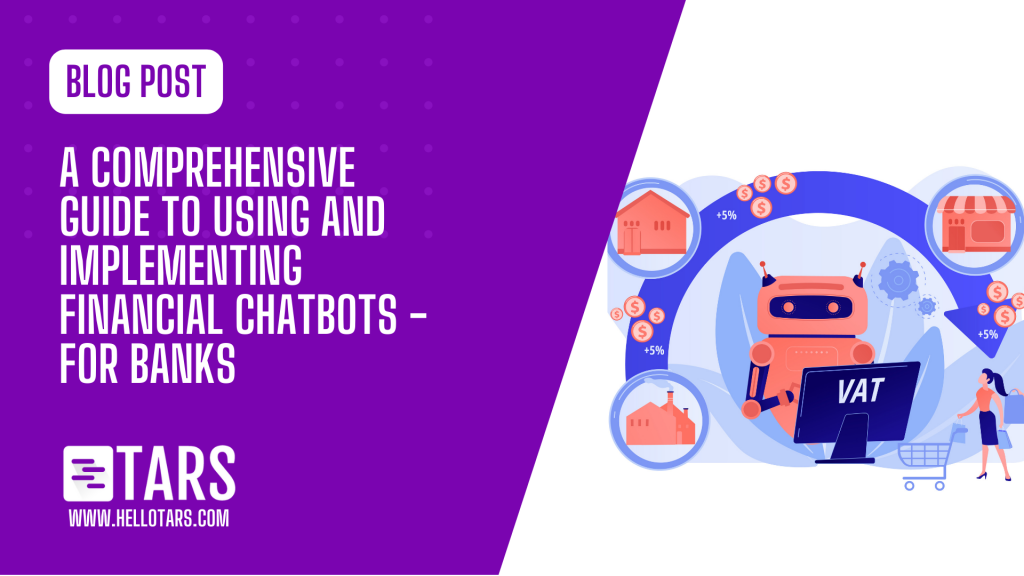Financial chatbots for banks can elevate banking operations and help you stay ahead of the curve. In this guide, we’ll take you through
✅the various ways in which financial chatbots can enrich the banking system and make it more efficient, and
✅the step-by-step process of implementing a chatbot in your bank
If this blog is unable to answer all your questions and queries, feel free to book a free demo. Our expert team is always ready to answer your questions and help you with your chatbot needs – from creating a chatbot to implementing it and ensuring it meets your goals.
Use Cases – How can Financial Chatbots for Banks Help the Banking System
In this section, we’ll explore some of the most common use cases for financial chatbots in banks.
Before we begin, if you want to interact with finance and banking chatbots for free and check out how they work, you can click here 👉 https://hellotars.com/chatbot-templates/finance-banking
Now let’s check out the various ways in which financial chatbots can make the banking system more efficient 👇

Customer service
One of the primary use cases for financial chatbots in banks is customer service. Chatbots can be programmed to handle a variety of customer queries and provide quick and efficient responses 24/7. This means that customers can get the information they need at any time of the day, without having to wait for business hours or speak to a human representative. Common customer service queries that chatbots can handle include account balances, transaction history, and credit card inquiries.
Account management
Financial chatbots can also be used for account management, allowing customers to perform various tasks related to their accounts. This includes tasks such as transferring funds, paying bills, and updating personal information. By automating these processes through chatbots, banks can increase efficiency and reduce the workload on their human representatives.
Sales and marketing
Another use case for financial chatbots in banks is sales and marketing. Chatbots can be programmed to engage with customers and promote bank products and services. This includes offering personalized product recommendations based on customer data, as well as answering questions about specific products and services.
Loan applications
Financial chatbots can be used to assist customers with loan applications. By automating the loan application process, banks can streamline the process and provide a faster turnaround time for loan approvals. Chatbots can also answer questions about loan options and eligibility criteria.
Investment management
Chatbots can also be used for investment management, providing customers with information on investment options and helping them make informed investment decisions. This includes providing information on investment products, market trends, and investment strategies.
Customer feedback
Financial chatbots can also be used to collect customer feedback, allowing banks to gain insights into customer satisfaction levels and areas for improvement. Chatbots can be programmed to ask customers for feedback after completing a transaction or interacting with the bank’s website or mobile app.
Language support
Chatbots can also be used to provide language support for customers who speak languages other than English. By offering multilingual chatbots, banks can improve the customer experience for non-English speaking customers and reduce language barriers.
Data analytics
Financial chatbots can be used for data analytics, providing banks with insights into customer behavior and preferences. By analyzing chatbot interactions, banks can gain insights into customer needs and preferences and use this information to improve products and services.
Fraud prevention
Finally, financial chatbots can also be used for fraud prevention. Chatbots can monitor customer accounts for suspicious activity and alert customers in real-time if any fraudulent transactions are detected. This can help customers protect their accounts and reduce the risk of financial loss.
Step-by-step Guide to Implementing Financial Chatbots in Banks

Before you can implement financial chatbots, it’s important to plan for their implementation. Here are the key factors to consider:
Step 1: Define the Purpose and Capabilities of Your Chatbot
Before you start building your chatbot, it’s important to define its purpose and capabilities. Consider what types of queries your customers are likely to have and what information your chatbot should be able to provide. For example, your chatbot might be able to answer questions about account balances, transaction history, or loan applications.
Step 2: Choose a Chatbot Platform
Once you’ve defined the purpose and capabilities of your chatbot, it’s time to choose a chatbot platform. There are many chatbot platforms available, each with their own features and capabilities. Some popular options include TARS, Google and Dialogflow.
Step 3: Build Your Chatbot
Once you’ve chosen a chatbot platform, it’s time to build your chatbot. This involves creating the conversation flow, designing the chatbot’s interface, and programming its responses. You may want to work with a developer or chatbot specialist to ensure that your chatbot is designed and programmed effectively.
Step 4: Train Your Chatbot
Before launching your chatbot, it’s important to train it to understand and respond to customer queries effectively. This involves providing your chatbot with a range of sample queries and responses to help it learn how to respond to different types of queries.
Step 5: Integrate Your Chatbot with Existing Systems and Data Sources
To ensure that your chatbot can provide accurate and up-to-date information to customers, it’s important to integrate it with your bank’s existing systems and data sources. This may involve working with your IT team to ensure that your chatbot can access the necessary data and systems.
Step 6: Launch and Test Your Chatbot
Once your chatbot is built and integrated with your systems, it’s time to launch and test it. Start with a soft launch to a small group of customers to ensure that everything is working as expected. Monitor your chatbot’s performance and customer feedback, and make adjustments as needed.
Best Practices for Financial Chatbots

To ensure that your financial chatbots are effective and provide a positive customer experience, it’s important to follow these best practices:
- Provide clear instructions: Make sure that customers know how to interact with your chatbot and what types of queries it can handle.
- Keep it simple: Use simple language and avoid technical jargon to ensure that customers can easily understand and interact with your chatbot.
- Personalize the experience: Use customer data to personalize the chatbot’s responses and provide a more tailored experience.
- Offer escalation options: Provide customers with the option to escalate to a human representative if their query is too complex for the chatbot to handle.
- Continuously monitor and improve: Regularly monitor your chatbot’s performance and customer feedback, and make adjustments as needed to ensure that it continues to provide a positive customer experience.
Let Us Help You Get Started

Now that you know the steps required to implement a chatbot successfully in your banking system, its time to get started and run ahead of the curve.
Simply book a free demo and our expert team at TARS will personally walk you through the entire process and help you get started.
Our team will:
✅Listen to your specific needs and requirements and help you find the right chatbot solution tailor-made for your unique business requirements.
✅Take care of the entire process from planning to creation to deployment.
✅Keep in touch to verify that the chatbot is functioning as planned and achieving your business objectives.
✅Take care of any customizations or modifications that you might need in the future.
TARS is trusted by Leaders and entrepreneurs across multiple industries. This includes: Vodafone, American Express, Nestle, Adobe and many more.
Book a free demo today to get started.

Ish is the co-founder at Tars. His day-to-day activities primarily involve making sure that the Tars tech team doesn’t burn the office to the ground. In the process, Ish has become the world champion at using a fire extinguisher and intends to participate in the World Fire Extinguisher championship next year.

0 Comments on "A Comprehensive Guide to Using and Implementing Financial Chatbots – for Banks"